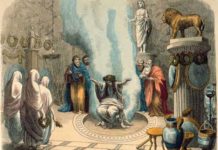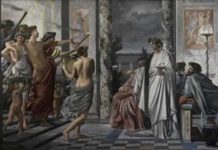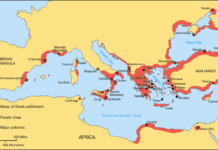
The most famous of all holding actions in military history where 300 Spartans made an Alamo of a mountain pass in Greece.
The Battle of Thermopylae took place during the Greco-Persia war in roughly 480BC. A force of three hundred free Spartans lead by their King stood alone against an invading army of three million, to defend their country at odds of a thousand to one.
The invasion was from Persia, lead by their tyrannical King, Xerxes, determined to conquer the divided Greeks. Ancient Greece was not the country you know today, but rather dozens of small ‘city-states’ bound by a few loose, even unofficial, agreements. The majority of these city-states of central and southern Greece met in Corinth at the first sign of invasion to form a response. It was decided that the combined army would be under Spartan command. The Spartans being a warrior culture whereas most of the other Greek units were made up of citizen soldiers who were nonprofessional. The fact that these citizen soldier armies had to be mobilized threatened to ruin the Greek defense hopes, as the Persian forces were assembled and marching.
The Spartan king Leonidas led the advance guard of the army to the mountain pass at Thermopylae, near present-day Lamia, the main passage into central Greece.
Thermopylae was seen as place to fight a delaying action to gain time for the mobilization. A defender could hold it with comparatively few men. The narrow valley was a strategic bottleneck that would permit only a small number of men to engage in combat at any one time. The Greeks and Persians arrived at the battlefield at roughly the same time. The Persian king sent his spies forward and found out exactly how small the Greek force was. He sent an emissary to negotiate surrender. The terms offered amounted to the Greeks being able to retire unmolested back to their homes in return for laying down their arms.
The response from the hopelessly outnumbered Spartan leader was recorded by the scholar Herodotus. The response was simple, “Molon Lebe” translated to “Come and Get them.” When a Spartan soldier was informed that the Persian army would fire so many arrows that they blotted out the sun, he remarked “Good, then we shall fight in the shade.”
Four days passed as Xerxes waited for the Greeks to leave. Persian scouts reported the Spartans exercising, bathing and cleaning their hair. These were traditions that the Spartan hoplite infantry undertook before going into battle. Amazed at their stubbornness, Xerxes ordered an attack on the dawn of day five, September 16th, 480BC.
The Spartans at first fell back, pulling the Persian troops into the narrow killing fields in a savage one on one combat. Enormous casualties were sustained by the Persians as the discipline of the Spartans held the line. Waves upon waves of leather clad Persian soldiers would serge forward, stepping upon the bodies of their dead comrades, only to die at the hands of the armored Spartans. Again and again the Persians would attack, only to be crushed and have to fall back. This went on for two days.
It was only when Ephialtes, a local peasant man, went to Xerxes with information of a path that went around the Greek position and compromised their lines, did the Persians gain the upper hand. Sending away most of his allies, Leonidas was determined to hold the now hopeless position to continue delaying the invaders as long as possible. The Spartans made a final stand on September 18th, fighting in a circle facing outward with enemies all around. In the final hours, the fighting was literally hand to hand combat, with Spartan Greek swords being broken from too many hits. When Leonidas himself was killed, the Persians offered to take the body of the slain King in return for the Spartan’s lives, but the men refused to abandon him. His body was later found by the Persians and crucified.
The remaining few Spartans were killed by a hail of arrows rained from afar, the Persians fearing being too close with these formidable warriors any longer. Thermopylae was always hailed as a triumph for Greek arms because the Persian army was crucially delayed. The distraction gave enough time for the rest of the Greek army to retreat into southern Greece and the Greek navy to form. To this day, some 2500 years later, a simple monument lies on that hallowed ground. It is engraved,
“Stranger, go tell the Spartans that here we are buried, obedient to their orders.”
Sources
- C. Hignett, Xerxes Invasion of Greece (1963 Oxford), (based on twenty-second logos, by Herodotus)
- P. Craig, Last Stands, Famous Battles Against The Odds (1998 Pargate)







